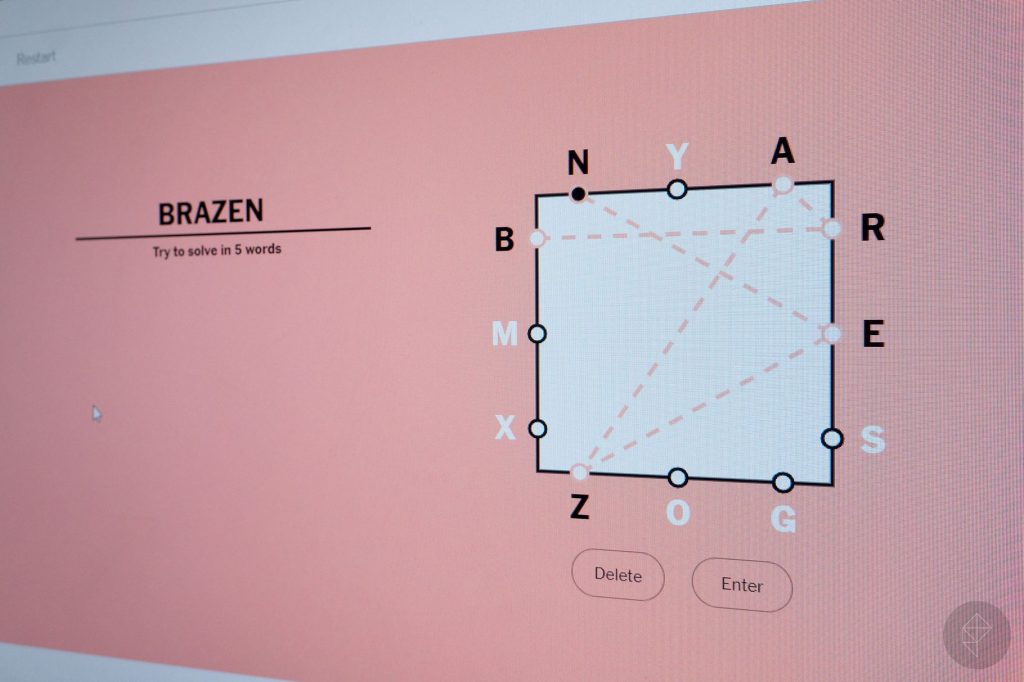
Wednesday, July 15
For several years now, Emily has been a dutiful solver of The New York Times Crossword Puzzle. When she was 10, she began doing the Sunday puzzle (which of course is more challenging than the daily puzzles). Then, after a hiatus of many years, she returned to doing the Sunday brain-beater and added the daily puzzle—and sometimes even the Mini crossword and the arithmetic-related KenKen.
This addiction was aided by her gaining access to electronic versions of Times stumpers. A Times puzzle subscription gives one access to a plethora of puzzles, perhaps eight to ten in total. Now, it’s with non-crosswords that she is primarily obsessed—Spelling Bee and Letter Boxed, but particularly the latter. When she’s not listening to Continuing Legal Education lectures or reading books, chances are she’ll be laboring over these.
Here’s how they work: With Spelling Bee, they give you seven letters—appearing visually in something like a cloverleaf. You make a list of as many words as you can with these seven letters. Each word must include the letter that appears in the center of the cloverleaf, and each word must be at least four letters long. The Times will either allow or disallow any proposed word. (No, there’s no electric shock administered if your word is disallowed.) As you create a list, you are given rankings that range from “good start” through “solid” to “amazing” and “genius.” Effectively, there is a 24-hour time limit—at the end of which time, a new puzzle appears along with the solution to the previous day’s puzzle.
Letter Boxed goes like this: Each day you see a box with three letters showing on each of the four sides. You type in any letter shown, then for a second letter you choose from any of the nine letters appearing on other sides of the square. (Your next letter cannot be one of those that appear on the side of the box where you began.) The goal is to use all twelve letters while making as few words as possible. Each new word must begin with the final letter used in the previous word.
A two-word solution (very difficult) is the ne plus ultra.
Each day, a new puzzle appears along with the Times’ own two-word solution to the previous day’s puzzle.
Emily says Letter Boxed is her favorite as it is the most challenging and allows for the most creativity. (Another challenge: our current problems with Internet access. Sometimes, the Internet goes down, she loses her work, and there’s no connection for hours.)
She has grown to dislike the crosswords, as they seem to include an ever greater number of pop-culture references. Moreover, there have been an increasing number of tricks and gimmicks—such as combining two letters in one box, or omitting certain letters altogether—and these put her off, too.
Letter Boxed calls on visual memory. You stare at the letters and, aha, you can visualize “cuneiform.” But that means that the next word must begin with an M. And that would be a snare—to get that day’s two-word solution, you needed to form “public” first, then “cuneiform.”
“It’s a logic problem, sort of like legal problems,” she reflects.
Such puzzles are not merely creative time-wasters, appropriate for lockdown’s long days. They are also brain-matter builders, good for staving off wastage of the little gray cells.
“Miss Lemon, my tisane si vous plais.”
Dinner: mozzarella cheese and tomato salad, cold sesame noodles.
Entertainment: More of Netflix’ Belgian thriller The Twelve.
